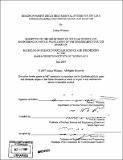Design of passive decay heat removal system for the lead cooled flexible conversion ratio fast reactor
Author(s)
Whitman, Joshua (Joshua J.)
DownloadFull printable version (3.126Mb)
Other Contributors
Massachusetts Institute of Technology. Dept. of Nuclear Science and Engineering.
Advisor
Neil E. Todreas.
Terms of use
Metadata
Show full item recordAbstract
The lead-cooled flexible conversion ratio fast reactor shows many benefits over other fast-reactor designs; however, the higher power rating and denser primary coolant present difficulties for the design of a passive decay heat removal system. In order to achieve passive cooling, enhancements are needed over current designs, such as the S-PRISM and ABR, which utilize passive cooling through the reactor vessel to atmospheric air. Enhancements such as axial fins, a perforated plate, and round indentations, or dimples, were considered as additions to the hot air riser to increase heat transfer. Other enhancements include a liquid metal bond between the reactor and guard vessels, and a dual-level design which introduces ambient temperature air halfway up the vessel wall. A code was written in Java to simulate these conditions, leading to a promising case using dimples on the guard vessel wall as the primary mode of heat transfer enhancement, and including the dual-level design. A conservative estimate of dimple performance indicates that during a passive decay heat removal shutdown, bulk primary coolant temperature will peak at 713 'C, giving a 12 OC margin to clad failure. Attempts were made to refine the uncertainty within the calculations using a computational fluid dynamics code, Fluent, but these ultimately were unsuccessful. Additional studies were conducted on the static stress imparted on the vessel, and the dynamic stress caused by a seismic event. The static stress was found to be within ASME code limits. Seismic analysis determined that a seismic isolation scheme would be necessary in order to prevent damage to the vessel during an earthquake.
Description
Thesis (S.B.)--Massachusetts Institute of Technology, Dept. of Nuclear Science and Engineering, 2007. Includes bibliographical references.
Date issued
2007Department
Massachusetts Institute of Technology. Department of Nuclear Science and EngineeringPublisher
Massachusetts Institute of Technology
Keywords
Nuclear Science and Engineering.